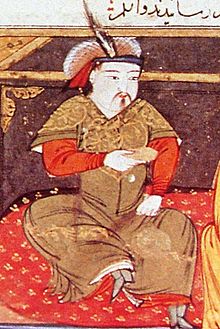Hulagu
| Hulagu Khan | |
|---|---|
| Ilkhan of the Ilkhanate | |

Painting of Hulagu Khan by Rashid-al-Din Hamadani, early 14th century.
|
|
| Reign | 1256– 8 February 1265 |
| Successor | Abaqa Khan |
| Born | 15 October 1218 |
| Died | 8 February 1265 (aged 46) |
| Burial | Shahi Island, Lake Urmia |
| Consort | Doquz Khatun |
| House | Borjigin |
| Father | Tolui |
| Mother | Sorghaghtani Beki |
| Religion | Nestorian Christianity, converted to Buddhism on his deathbed |
Hulagu Khan, also known as Hülegü or Hulegu (Mongolian: Хүлэгу хаан; Chagatai: ہلاکو; Persian: هولاکو خان; Chinese: 旭烈兀; c. 1218 – 8 February 1265), was a Mongol ruler who conquered much of Western Asia. Son of Tolui and the Keraite princess Sorghaghtani Beki, he was a grandson of Genghis Khan and brother of Ariq Böke, Möngke Khan, and Kublai Khan.
Hulagu's army greatly expanded the southwestern portion of the Mongol Empire, founding the Ilkhanate of Persia, a precursor to the eventual Safavid dynasty, and then the modern state of Iran. Under Hulagu's leadership, the siege of Baghdad (1258) destroyed the greatest center of Islamic power and also weakened Damascus, causing a shift of Islamic influence to the Mamluk Sultanate in Cairo.
Hulagu was born to Tolui, one of Genghis Khan's sons, and Sorghaghtani Beki, an influential Keraite princess. Sorghaghtani successfully navigated Mongol politics, arranging for all of her sons to become Mongol leaders. She was a Christian of the Church of the East (often referred to as "Nestorianism") and Hulagu was friendly to Christianity. Hulagu's favorite wife, Doquz Khatun, was also a Christian, as was his closest friend and general, Kitbuqa. It is recorded however that he converted to Buddhist as he neared death, against the will of Doquz Khatun. The erection of a Buddhist temple at Ḵoy testifies his interest in that religion.
...
Wikipedia
